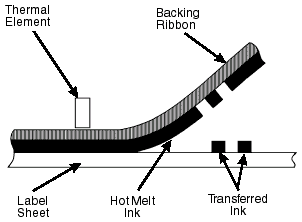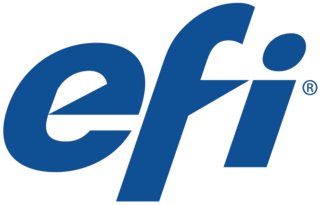
Screen printing is a printing technique where a mesh is used to transfer ink onto a substrate, except in areas made impermeable to the ink by a blocking stencil. A blade or squeegee is moved across the screen to fill the open mesh apertures with ink, and a reverse stroke then causes the screen to touch the substrate momentarily along a line of contact. This causes the ink to wet the substrate and be pulled out of the mesh apertures as the screen springs back after the blade has passed. One colour is printed at a time, so several screens can be used to produce a multi-coloured image or design.

Printmaking is the process of creating artworks by printing, normally on paper, but also on fabric, wood, metal, and other surfaces. "Traditional printmaking" normally covers only the process of creating prints using a hand processed technique, rather than a photographic reproduction of a visual artwork which would be printed using an electronic machine ; however, there is some cross-over between traditional and digital printmaking, including risograph.

The CMYK color model is a subtractive color model, based on the CMY color model, used in color printing, and is also used to describe the printing process itself. The abbreviation CMYK refers to the four ink plates used: cyan, magenta, yellow, and key (black).

Printing is a process for mass reproducing text and images using a master form or template. The earliest non-paper products involving printing include cylinder seals and objects such as the Cyrus Cylinder and the Cylinders of Nabonidus. The earliest known form of printing evolved from ink rubbings made on paper or cloth from texts on stone tablets, used during the sixth century. Printing by pressing an inked image onto paper appeared later that century. Later developments in printing technology include the movable type invented by Bi Sheng around 1040 AD and the printing press invented by Johannes Gutenberg in the 15th century. The technology of printing played a key role in the development of the Renaissance and the Scientific Revolution and laid the material basis for the modern knowledge-based economy and the spread of learning to the masses.

Dye-sublimation printing is a term that covers several distinct digital computer printing techniques that involve using heat to transfer dye onto a substrate.

A T-shirt is a style of fabric shirt named after the T shape of its body and sleeves. Traditionally, it has short sleeves and a round neckline, known as a crew neck, which lacks a collar. T-shirts are generally made of stretchy, light, and inexpensive fabric and are easy to clean. The T-shirt evolved from undergarments used in the 19th century and, in the mid-20th century, transitioned from undergarments to general-use casual clothing.

Giclée describes digital prints intended as fine art and produced by inkjet printers. The term is a neologism, ultimately derived from the French word gicleur, coined in 1991 by printmaker Jack Duganne. The name was originally applied to fine art prints created on a modified Iris printer in a process invented in the late 1980s. It has since been used widely to mean any fine-art printing, usually archival, printed by inkjet. It is often used by artists, galleries, and print shops for their high quality printing, but is also used generically for art printing of any quality.

Thermal-transfer printing is a digital printing method in which material is applied to paper by melting a coating of ribbon so that it stays glued to the material on which the print is applied. It contrasts with direct thermal printing, where no ribbon is present in the process.
Prepress is the term used in the printing and publishing industries for the processes and procedures that occur between the creation of a print layout and the final printing. The prepress process includes the preparation of artwork for press, media selection, proofing, quality control checks and the production of printing plates if required. The artwork is quite often provided by the customer as a print-ready PDF file created in desktop publishing.
Hexachrome is a discontinued six-color printing process designed by Pantone. In addition to custom CMYK inks, Hexachrome uses orange and green inks to expand the color gamut for better color reproduction. It is therefore also known as a CMYKOG process.
Color printing or colour printing is the reproduction of an image or text in color.

HP Indigo Division is a division of HP Inc.'s Graphic Solutions Business. It was founded in 1977 in Israel and acquired by Hewlett-Packard in 2001. HP Indigo develops, manufactures and markets digital printing solutions, including printing presses, proprietary consumables/supplies and workflow solutions. HP Indigo has offices around the world, with headquarters in Ness Ziona, Israel.

Textile printing is the process of applying color to fabric in definite patterns or designs. In properly printed fabrics the colour is bonded with the fibre, so as to resist washing and friction. Textile printing is related to dyeing but in dyeing properly the whole fabric is uniformly covered with one colour, whereas in printing one or more colours are applied to it in certain parts only, and in sharply defined patterns.

Jennifer A. Lewis is an American materials scientist and engineer, best known for her research on colloidal assembly of ceramics and 3D printing of functional, structural, and biological materials.

Transfer paper is used in textiles and arts and crafts projects. Transfer paper is a thin piece of paper coated with wax and pigment. Often, an ink-jet or other printer is used to print the image on the transfer paper. A heat press can transfer the image onto clothing, canvas, or other surface. Transfer paper is used in creating iron-ons. Transfer papers can also be used for the application of rhinestones to clothing and other arts and crafts projects.
Direct-to-garment printing (DTG) is a process of printing on textiles using specialized aqueous ink jet technology. DTG printers typically have a platen designed to hold the garment in a fixed position, and the printer inks are jetted or sprayed onto the textile by the print head. DTG typically requires that the garment be pre-treated with a PTM or pre-treatment machine, allowing for the following:
Digital textile printing is described as any ink jet based method of printing colorants onto fabric. Most notably, digital textile printing is referred to when identifying either printing smaller designs onto garments and printing larger designs onto large format rolls of textile. The latter is a growing trend in visual communication, where advertisement and corporate branding is printed onto polyester media. Examples are: flags, banners, signs, retail graphics.

Electronics for Imaging, Inc. (EFI) is an international company based in Silicon Valley that specializes in digital printing technology. Formerly located in Foster City, California, the company is now based in Fremont. On July 1, 2015, EFI entered the textile printing marketing with the acquisition of Italian digital textile company Reggiani Macchine. On June 16, 2016, EFI acquired Optitex, a 3D digital workflow provider.

Benny Landa is an Israeli entrepreneur and inventor. He founded Indigo Digital Press in 1977 and The Landa Group in 2003. In the print production industry, Landa has been called the "father of commercial digital printing."
Direct-to-film printing (DTF) is a process of printing on textiles. The process involves the direct transfer of a design by first printing it on a special film and then using a heat press to transfer the design to a garment.














